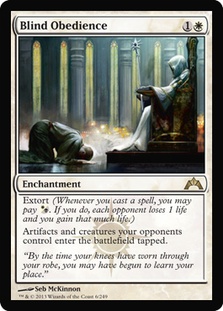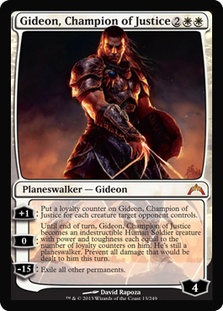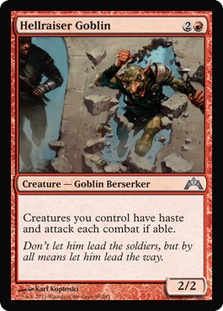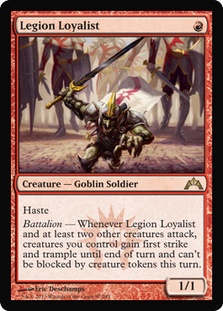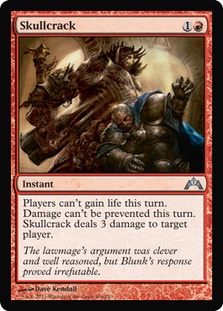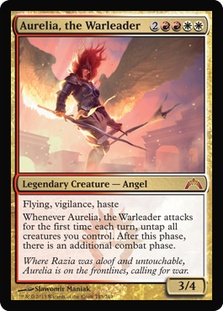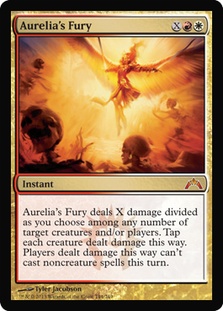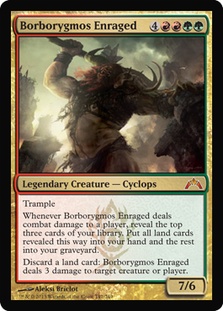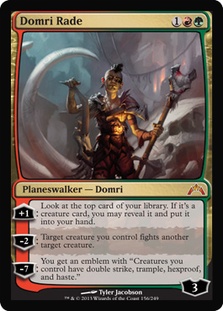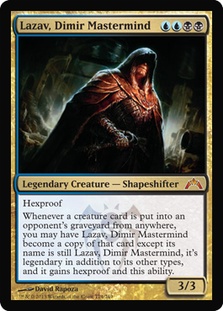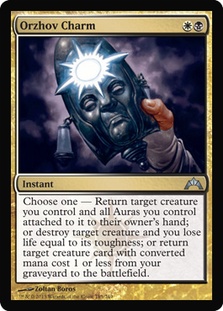Article topic suggestion from former StarCityGames.com editor Steve Sadin:
"When you get a chance, you should write an article on how you build (and when/why you decide to play) beatdown decks."
Let’s one up that. What are the general conditions when I end up playing any archetype?
Aggro: The short version is I play aggro when I have no desire to play any of the other decks, but that makes it sound like too much of a last resort. Often, formats end up in these hard Rock/Paper/Scissors setups between a few slower decks like current Standard, where it is basically impossible for Rock to beat the trump Paper. In turn, Paper will have a number of serious flaws that also exclude it from being a strong choice. This Standard format became like that towards the end, with another example being post-Jace ban Standard (Caw-Blade was trumped by Valakut, which lost to Twin, which lost to itself; after a long string of losses, I played Tempered Steel and bashed people).
In these formats, I opt to play something that can ignore these battles and just attack people. There is the rare aggro deck where you feel extremely comfortable in all the relevant matchups and are able to battle through everything, but most of the time playing aggro you are accepting you will lose some games but win most of them.
Midrange: When midrange decks are good, you tend to have combo decks that are easy to race and control decks with no real end game trump. In a world where no one has a ten for one or ignores card advantage in the long term, having all two for ones adds up. The current Standard format is very close to this, with no combo outside of slow ramp decks, but the control decks do have trumps in the form of Sphinx’s Revelation and Jace, Memory Adept. Even midrange decks have Rakdos’s Return as an X-for-one to "break" a mirror.
Control: Usually, I avoid control decks in broad formats and only play them when I know I will play against a handful of known decks almost every round. Unless you can specifically tailor your answers to a known subset of decks, it’s easy to play something you have no profitable interaction for. There’s always the chance your answers and finishers are so powerful that it really doesn’t matter what they are doing (i.e., Cryptic Command and Cruel Ultimatum), but situations where those cards exist are rare. That said, Thragtusk plus Sphinx’s Revelation does come close.
Combo: On the other hand, I tend to lean towards combo in more varied formats. When you can’t prepare for everything, it’s better to be able to kill anything. In a well-defined format with only a few decks, people usually can appropriately prepare for a combo deck. Your openings there are to come out of right field with something people aren’t expecting (i.e., Eggs at Pro Tour Return to Ravnica) or play something so broken that it doesn’t matter if people know about it. When the latter happens, something seriously wrong is going on that likely won’t last, so take the wins while you can.
Note: there are formats where the best deck to just bash people with is aggro, not control. These are usually smaller formats where the fastest combo deck is slower than the aggressive decks. Knowing the critical turn to race aggressive decks is an important part of determining if true combo is the right route to go down for the "bad deck punisher" role in the metagame.
Hybrid-Control (i.e., Faeries, Caw-Blade): In general, I’ve found these decks are either unplayable or the best deck. The deck either has the critical mass of efficient threats and cheap answers it needs to function or is a pile. Figuring out whether the first exists is much easier than the second, so start there.
Of course, all of these are short because they aren’t really how you should choose decks. Here is what actually matters.
(Any Archetype, Any Deck): This is the deck I’ve been the most comfortable with and have been winning the most with.
Generalizations are fine starting points, but in the end, what matters is how things play out for that specific format.
So let’s get down to the real part. How do I actually build and decide when to play aggro decks (or anything else for that matter)?
Step 0: Play some games, or even just watch some, and learn what matters.
Some people show up to an event with a deck on pure theory craft. Looking at event Top 8s doesn’t give you a good picture of a format. Well, it might, but not enough to win an event. Deck choice, while a large part of how you finish, is dwarfed by technical play in terms of actually doing well at an event. You can’t learn technical play from staring at decklists.
Some people have built up the required skill set to just pick up a deck and go, but usually that requires a lot of prior knowledge of similar situations. Even then, it’s easy to not understand a matchup and lose games you should have won.
Don’t be lazy. If you want to win, actually become familiar with not just the decks in the format but how they play against each other. This means the games you play/watch should be of relevant decks, not midnight brew mirror matches. You should also focus on who wins and more so how they win. What are the turning points, and what cards are determining the winners? From here, you can start posing relevant questions to try to solve problems and identify sideboard cards that actually matter. Many times, people’s ideas of who wins in certain matchups are tainted by consistent misplays (or poor sideboarding) on one side. The hive mind is not always correct on these issues.
Step 1: Start with what seems right or is obvious.
Are you attacking the format from the top down or bottom up? You can either start with one deck you want to be good or start with the known "best deck" and figure out why it’s the best or how to fight it. Obviously, these aren’t exclusive; some people just want Jund to be the hero.
Regardless, you should be testing in a semi-tournament setting. This means you are testing short stretches against a variety of decks, preferably with sideboarding included. Changes should be made after a few different sets, mostly to prevent skewed reactions to one matchup. That said, don’t worry at this point about hyper-focused tuning. Just make the changes you can and go from there.
Important note: starting on a brew usually means throwing away a lot of valuable information. If you decide to switch to another known deck, having played from the other side of the matchup gives you a ton of perspective that accelerates your learning. If you play a brew and ditch it, this doesn’t apply. You still gain information about how specific cards perform against the format, but that’s only because you gain that just by playing spells.
Step 2: Unless you are beating everything, jam a new deck. Then repeat this step.
By now, you should have a decent understanding of the key players in the metagame. If you aren’t comfortable with how your deck of choice is performing against the field, you should have enough information to make a new educated guess as to what you should play. If not, switch to another major deck and learn more. Eventually, you will find something that is good or at the least which option is the closest to being there.
One last thing: when it comes down to the wire and you are stuck, just ask yourself why you are playing something. If you can’t come up with a good answer, odds are you don’t have one.
Gatecrash Specifics
I’m going to avoid talking about broadly good cards here. It will be hard to determine which Prime Speaker Zegana shell abuses the card the most until you see all of them in action.
Instead, I’m going to talk about a lot of role-players. With these cards, it’s easy to see traps that people might fall into when building decks with them and provide alternative suggestions.
Blind Obedience
No, this card does not stop the Splinter Twin combo. It turns it from an immediate win to a kill in one turn. They just pass and on your end step make infinite tapped tokens that then live until their end step and untap on their turn.
Of course, that just means the card isn’t a good hate enchantment for Modern (though even if it worked as people thought, I would be skeptical that it would be better than other options). I think the card is still considerable for smaller formats. Again, maybe not a maindeck staple, but as a Falter / burn spell in aggro or a way to remove the ability haste from your opponent’s red creatures, it does a little bit of work.
Gideon, Champion of Justice
I am not excited about this card, but I want to elaborate on why. The shortcoming of this card is not that is isn’t Gideon Jura. The closest thing to this we have seen is Koth of the Hammer.
Of course, Gideon, Champion of Justice doesn’t have haste. The Supreme Verdict effects it dodges are also getting worse already with Boros Charm joining the format. The real kicker for me is Azorius Charm. Azorius Charm punishes you for not playing Thragtusk or Huntmaster of the Fells in your midcurve more than almost any other card in the format, and it lines up with one of the huge incentives to be blue in the format.
I expect most of the decks you actually want Gideon against (Hallowed Fountain control decks) are going to be full up on Azorius Charm to punish you for having a four-drop without haste or any real immediate board impact. You can opt to not attack, but is that really going to win the game? It takes a long time to reach fifteen when you are counting by ones against a deck that likely has Detention Sphere.
Short version: Gideon isn’t bad because he compares poorly to old Gideon. He is bad because the decks he should be good against are going to be loaded with answers to him.
Aside: why are these decks full on Azorius Charm? It’s one of the best two-drop removal spells against the obvious Sacred Foundry / Stomping Ground aggro decks, especially if people default to Rietzl W/R. Ever get a Champion of the Parish put on top of your deck? I did once, and I refuse to let it happen again.
Hellraiser Goblin
I’ve heard a few people talk about being interested in the Fires of Yavimaya effect. Be aware that playing this card requires you to have creatures that don’t have haste that cost more than it. For example, your Gruul deck with this card probably wants Wolfir Silverheart and maybe even Druid’s Familiar and is less likely to want Hellrider or Thundermaw Hellkite.
Also, you are not obligated to first main phase this creature in Limited. The old Momir Avatar of Slaughter dilemma proves itself useful!
Legion Loyalist
Similar to Hellraiser Goblin, this guy needs the proper support. It doesn’t fit in the red shell I played of all 2/Xs. If you play this card, you likely want Gore-house Chainwalker on turn 2. Cracking the three power barrier on first strike to take down a Thragtusk is a big deal. I’m just not sure if you want a big three-drop like Hellhole Flailer to keep up with this plan or still just old Pyreheart Wolf. I only say this because it’s nearly impossible to make multiple double blocks under the "tokens can’t block" restriction.
This last part does assume you aren’t playing Frontline Medic. Of course, battalion on both of these guys is a bit of overkill. I doubt a deck with one is going to want the full complement of the other, and I’m pretty sure I know which one is the better card.
Skullcrack
The deck that wants Skullcrack is not the Mono-Red Aggro deck I played in Atlantic City. The vast majority of my burn spells were aimed at creatures, not the face. Even when they Thragtusk, in the games I’m going to win a Hellrider or Pyreheart Wolf would deal more damage than leaving up two mana.
Skullcrack decks want a lot of burn. They want to Skullcrack, untap, and use that time to launch off a lethal Volley. They don’t want 30 creatures, and they likely don’t want any five-drops. Maybe a few fours, but that’s pushing it.
Alpha Authority
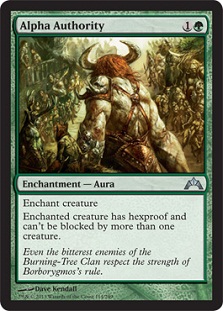
This card is not playable, but it’s funny how things have changed. Canopy Cover was something that people were really interested in with Infect, but now it’s a head scratcher to see hexproof granted by an aura. Aren’t my guys with enchantments on them supposed to have that ability already?
Aurelia, the Warleader
I’ve heard a lot of people talking about how a bunch of things are combos with this card. The real combo with this card is killing their Restoration Angel so it doesn’t trade by blocking both combats. You shouldn’t need to put in the extra work to kill them with this card. It’s a Rorix Bladewing. You attack, they die.
Aurelia’s Fury
I think people aren’t really sure what they are doing with this card. I’ve seen all sorts of lists just jamming this card for seemingly no reason. As a removal spell, it falls very short. I don’t want to be paying retail to burn down creatures with this effect. Devil’s Play was always a poor removal spell, and this is even worse.
If I’m playing this card, I have a deck that builds enough mana and board presence to use it as Fireball or Falter. It’s like a Bonfire, but you trade the ability to come from behind with it for it always being miracled. In my mind, that just means I’m not boarding it out against control since I want instant Blazes.
Borborygmos Enraged
I’m just going to say that there is a reason this costs eight. Seismic Assault at three is absurd, and putting it on a creature basically forces you to cost it somewhere that the decks that are going to cheat it into play have to work to hard cast it.
Domri Rade
I expect this card to be underrepresented in decklists in articles but well represented in decklists that win. It’s the kind of card you forget about when building an aggressive curve, but the people that make smart decisions and find room for it will be rewarded.
Lazav, Dimir Mastermind
One of the big upsides of Clones in this format is that they do great Thragtusk and Angel of Serenity impressions. I’m lost a few games to my Angel of Serenity getting Evil Twinned, and it feels downright miserable. They also kill Geist of Saint Traft on the spot.
Which of these does Lazav do again?
Orzhov Charm
Note that this does say destroy any target creature. I’m pretty sure this is going to be an almost one mode Charm in a lot of my first decks with it, and I’m ok with that. Killing Obzedat, Ghost Council, Olivia Voldaren, and Duskmantle Seer is a relevant ability for a two mana, easily castable kill spell.
I’ll be back next week with something a bit more immediately applicable: a curve-based breakdown of Gatecrash for Limited. Given the high density of aggressive abilities, expect every turn to be hugely relevant.

